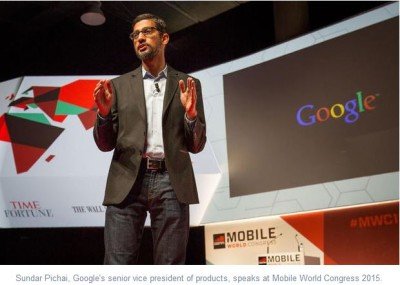As the Mobile World Congress kicked off on March 2, 2015, there were several speakers from stalwarts to newcomers showcasing their products. Among the speakers was Sundar Pichai, the senior vice president of products at Google. He spoke with a presentation of about 45 minutes – on different topics and products related to Google. Here are some important takeaways from his speech and presentation.
 Pichai said keeping people connected is one of the primary aims at Google and he stressed on three existing projects that he said will affect the future of Internet distribution. Google Fiber is already known to many as it is a service readily available in urban areas. It remains a priority on Google’s list.
Pichai said keeping people connected is one of the primary aims at Google and he stressed on three existing projects that he said will affect the future of Internet distribution. Google Fiber is already known to many as it is a service readily available in urban areas. It remains a priority on Google’s list.
The other plan related to keep people connected is the Project Loon. This project had seen many headlines as it aims to connect rural areas using cellular technology. At the base of this project are large balloons that float in stratosphere (higher atmospheric regions) so that they can stay at a point just as satellites stay in orbits. They may not be as exact positioned always but a six month connectivity per balloon seems good. Project Loon will see many partnerships with different telecom service providers so that people can use their cellular signals to connect to the Internet. Already, Loon has partnered with Vodafone, Telsra, and Telefonica.
The third plan in the connectivity factor is the usage of drones. They are calling it Titan. Using drone technology, Google intends to provide connectivity in regions where connectivity is an emergency. This is also dependent on cellular data transmission.
Pichai said Google does not have plans to become Mobile Virtual Network Provider unlike the rumors that have been floating around for a while. Google is not planning to be a full time Mobile Virtual Network Provider but it is working with other companies to the end. The most likely partners for this project would be Sprint and T-mobile as they have plenty of unused bandwidth and are willing to team up with Google.
The Mobile Virtual Network Provider thing would be advantageous to Google in terms of data collection and studying user behavior. However, Pichai said it will be using MVNP for reconnecting dropped calls and things like that so that they are useful to the end users.
Pichai also spoke of Android Pay, an API layer in Android that will allow developers to integrate payment systems into Android based apps. He said that the Google Wallet itself would be a customer of Android Pay. Talking about Android, he also stressed that Android One will be more focused henceforth in bringing down the costs of devices. Android One is a project that aims to provide devices at $100 or lower price to emerging markets worldwide. Pichai said they are aiming to bring it down to $50 and research is on to cut down on costs of manufacturing.
Leave a Reply